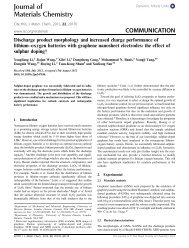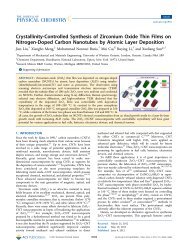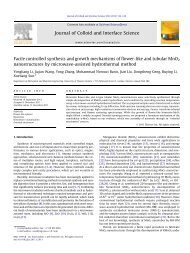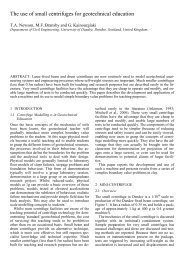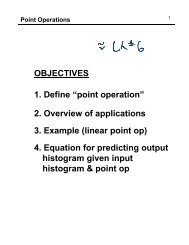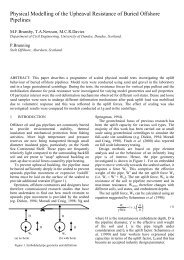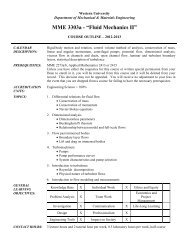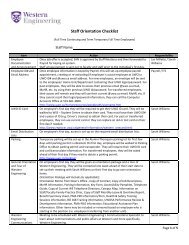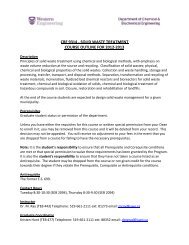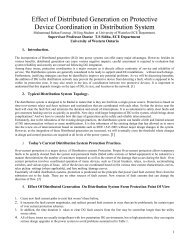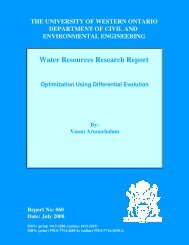Seismic Behavior of Gravel Drains and Compacted Sand Piles using ...
Seismic Behavior of Gravel Drains and Compacted Sand Piles using ...
Seismic Behavior of Gravel Drains and Compacted Sand Piles using ...
Create successful ePaper yourself
Turn your PDF publications into a flip-book with our unique Google optimized e-Paper software.
Excess pore water pressure<br />
Figure 7. Time histories <strong>of</strong> accelerations recorded in Test C<br />
Time histories <strong>of</strong> excess pore pressure ratio, ru, recorded at depths <strong>of</strong> 15cm <strong>and</strong> 35cm below the center <strong>of</strong> the foundation<br />
are shown in Figures 8-10. Comparing these figures with the acceleration time histories indicates that acceleration<br />
amplitudes attenuated due to excess pore pressure buildup since the chronological agreement between the maximum<br />
excess pore pressure <strong>and</strong> the attenuation <strong>of</strong> acceleration amplitude is clearly seen from these figures. Maximum excess<br />
pore pressure ratio (ru) was achieved during some initial cycles <strong>and</strong> remained almost unchanged within the shaking<br />
period. The maximum excess pore pressure ratios in all tests, were almost the same however, the number <strong>of</strong> cycles<br />
ca<strong>using</strong> this maximum ru was different. The gravel drains increased the resistance against liquefaction <strong>and</strong> ru reached its<br />
maximum within a larger number <strong>of</strong> cycles. A similar behavior was observed in test C with the compacted subsoil.<br />
Compaction was able to increase liquefaction resistance more than gravel drains. During shaking, gravel drains were not<br />
able to reduce the excess pore pressure considerably; <strong>and</strong> changes in the behavior <strong>of</strong> the remediated ground was<br />
primarily a result <strong>of</strong> the stiffening effect <strong>of</strong> the gravel drains.<br />
After the shaking excess pore water pressures at deeper locations started to dissipate, however they increased in<br />
shallower deposits due to the upward movement <strong>of</strong> water from deeper strata <strong>and</strong> flows draining from the surrounding far<br />
field soils; such a phenomenon was also observed by Liu <strong>and</strong> Dobry (1997) as well as during the 1995 Kobe earthquake,<br />
where upward seepage was observed in Rokko Isl<strong>and</strong> an hour after the main event (Shibata et al., 1996). This migration<br />
<strong>of</strong> water may reduce the strength <strong>of</strong> surface soils <strong>and</strong> generate "secondary" (or seepage induced) liquefaction, ca<strong>using</strong><br />
large deformations or loss <strong>of</strong> bearing capacity (EERC, 1975; Yoshimi <strong>and</strong> Kuwabara, 1973).<br />
Furthermore the excess pore water pressure ratios show that at any specific depth there was a moment after which, the<br />
excess pore pressures started to dissipate faster. This is the initial period, where vertical dissipation had not had a chance<br />
to get hold on the soil at that corresponding depth <strong>and</strong> only radial drainage was experienced at that depth.<br />
After shaking the differences in dissipation rates <strong>of</strong> various tests were remarkable which indicates that gravel drains<br />
accelerated the excess pore pressure dissipation after shaking, showing their effectiveness in non-dynamic cases i.e.<br />
effectively mitigating secondary liquefaction due to the upward flowing water after earthquake. The deeper pore water<br />
pressure used the full drain capacity <strong>and</strong> overlying deposits waited for the way to be clear. At shallower sections water<br />
left through surface rather than the drain itself. Such phenomenon was also observed by Brennan <strong>and</strong> Madabhushi<br />
(2002).





